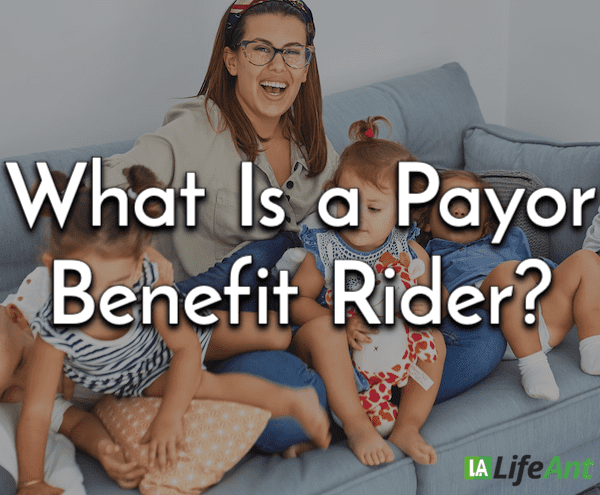What Is a Payor Benefit Rider?

Parents often take out life insurance policies on their minor children. But what happens if the parent in this case dies or becomes disabled while the child is still a minor?
In some cases, a provision known as a payor benefit rider will ensure that the juvenile doesn’t have to continue paying the premiums on the policy. The same may also apply to spouses who find themselves in similar situations.
Payor benefit riders can be confusing to some people, but they’re important to understand if you have, or want to purchase life insurance. Here’s a more in-depth explanation of what a payor benefit rider is.
What a Payor Benefit Rider Covers
The insured person on a life insurance policy isn’t always the payor. Sometimes, parents will take out a life insurance policy for their minor children but will pay the monthly premiums themselves. Spouses will sometimes do the same for each other.
If the payor becomes disabled or dies, though, what happens if the insured wants to keep the policy active? In most cases, the insured would be the one responsible for paying the monthly premiums if they want to keep the policy active.
This could prove to be difficult in some instances, though. Minor children, for instance, probably won’t have the financial means to pay for insurance premiums, or even the wherewithal to know what to do. A husband or wife mourning the loss of a spouse — or caring for them when they’re disabled — may also have difficulty keeping up with the payments.
A payor benefit rider would help in these cases, and more, by waiving the premium costs of the insurance plan and having the insurance company become the new payor of the plan.
How a Payor Benefit Rider Is Written
A payor benefit rider is an addendum to a life insurance policy. In other words, it’s not a basic part of the policy itself. It must be added as an extra document to ensure that it applies if certain conditions are met.
Payor benefit riders are written in much the same way that disability policies are. It’s possible that a person may be approved for a specific life insurance policy but then be denied the option of adding a payor benefit rider.
That’s because the addition of this rider would require the life insurance company to take into consideration the health and well-being of two people on the policy — the person being named on the insurance plan and the person who is responsible for paying the premiums.
As such, an insurance company will analyze the health, age, and other conditions of both the payor and insured when deciding whether to approve a payor benefit rider. The rider, in this case, is seen as a type of insurance itself, since it provides a benefit if certain conditions are met.
When a Payor Benefit Rider Is Activated
Not every payor benefit rider applies to the same situations. Some may kick in when the payor dies or becomes disabled. Others may only apply if the payoff becomes disabled, and is not activated in the case of the payor dying.
If the payor benefit rider doesn’t apply to the death of a payor, then the owner of the policy may still have options. They could either begin making the premium payments on their own, or they could designate a new payor on the policy.
To be considered disabled, certain conditions will need to be met. In most cases, a payor benefit rider will only activate if the payoff becomes completely disabled. A partial disability oftentimes does not qualify for the rider to come into play.
When a Payor Benefit Rider Expires
Another important aspect of a payor benefit rider is that they don’t remain in effect for the entire life of the insurance policy. They expire, based on a few different circumstances.
For policies that cover minor children, a payor benefit rider may only be in effect until the child reaches the age of 21. The insurance company will set the expiration age in these circumstances based on when they will determine that a child would reach an age that they could reasonably be expected to pay the premiums on their own.
At the same time, payor benefit riders will often expire once the payor reaches the age of 60 to 65. Again, the exact age the rider expires may differ from company to company and policy to policy, so it’s very important to understand all the fine print details of your life insurance policy.
When a Payor Benefit Rider Is Included
Not all life insurance policies automatically include a payor benefit. In fact, most do not, which is why a special rider is needed to add the benefit to the life insurance policy.
A payor benefit can be an essential part of a permanent life insurance plan, making sure that insured people aren’t forced to pay premiums they can’t afford or risk having their life insurance policy lapse.
This is especially pertinent to, and important for, life insurance policies that are taken out on juvenile children. When the payor of the policy becomes disabled in these cases, it can often be impossible for someone to step in to pay the monthly premiums to make sure the policy continues.
In these cases, a payor benefit rider will protect the plan, and continue to cover the insured for the life of the policy.






